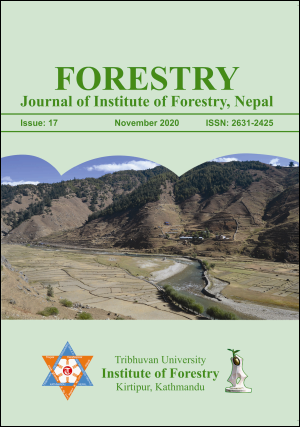Soil Erosion Estimation Using RUSLE Modeling and Geospatial Tool: Case Study of Kathmandu District, Nepal
DOI:
https://doi.org/10.3126/forestry.v17i0.33627Keywords:
RUSLE, GIS, risk zone, erosion, conservationAbstract
Revised Universal Soil Loss Equation (RUSLE) model is applied in this study to evaluate the risk of erosion in Kathmandu district. The calculation of erosion requires certain data from various sources available in different formats and scales. Geographic Information System (GIS) was used which allowed considerable time savings in the processing of spatial data, screening the effects of each factor affecting soil erosion. Among various erosion factors, topography, rainfall, soil properties, and soil conservation practices were used for the study. Average soil loss was calculated by multiplying these factors. Final results of soil erosion rates were separated into six classes based on erosion severity, in which 2.18% of land (> 80Mg ha-1yr-1), followed by 2.85% of land (40-80 Mg ha-1yr-1), 5.56% of land (20-40 Mg ha-1yr-1), 8.73% of land (10-20 Mg ha-1yr-1), 10.53% of land (5-10 Mg ha-1yr-1) and 70.14% of land (0-5 Mg ha-1yr-1), falls under very severe, severe, very high, moderate and low severity zone respectively. Area having high slope length (LS) factor has high erosion rate. In Dakshinkali, Nagarjun and Budanilkantha area, there is high erosion rate. From the result, spatial distribution of soil erosion across Kathmandu district, can be applied for management and controlling the erosion.
Downloads
Downloads
Published
How to Cite
Issue
Section
License
© Tribhuvan University, Institute of Forestry




